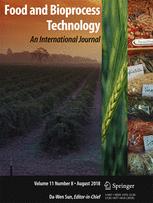Ver ítem
- xmlui.general.dspace_homeCentros Regionales y EEAsCentro Regional Buenos Aires NorteEEA PergaminoArtículos científicosxmlui.ArtifactBrowser.ItemViewer.trail
- Inicio
- Centros Regionales y EEAs
- Centro Regional Buenos Aires Norte
- EEA Pergamino
- Artículos científicos
- Ver ítem
Cornflake production process: state diagram and water mobility characteristics
Resumen
The aim of this work was to fully understand the physicochemical events involved in the development of the cornflake structure, taking into consideration the water sorption characteristics and state changes in the solid phase as a function of temperature and water content. Complementarily, time-resolved proton nuclear magnetic resonance (1H-TD-NMR) was used to evaluate the dynamic aspects at different stages of the classical cornflake production process.
[ver mas...]
The aim of this work was to fully understand the physicochemical events involved in the development of the cornflake structure, taking into consideration the water sorption characteristics and state changes in the solid phase as a function of temperature and water content. Complementarily, time-resolved proton nuclear magnetic resonance (1H-TD-NMR) was used to evaluate the dynamic aspects at different stages of the classical cornflake production process. Processing had the effect of reducing the water sorption capacity of the samples and of increasing the sorption energy. While the minimal water content necessary to detect starch gelatinization was lower than the water content at which frozen water was detected by DSC (W = 24%), water excess for an adequate cooking needs to be higher than this value. By describing the process using supplemented state diagrams, it was possible to delimitate regions in which the main components (starch and proteins) underwent specific changes such as gelatinization or crosslinking. The data of comparative mobility of water populations helped to understand the occurrence of those changes. The physical state of the samples could be established for each process stage, the matrix was soft and malleable when important internal and external forces were applied which allowed the change of shape, microstructure, and appearance of the product. Physical hardening occurred after toasting to create the typical expected crispy texture. The data of comparative mobility of proton populations helped to understand the occurrence of those changes, the conditions prevailing in each stage, and the physical state of the sample.
[Cerrar]

Autor
Farroni, Abel Eduardo;
Buera, María del Pilar;
Fuente
Food and Bioprocess Technology 7 (10) : 2902–2911 (October 2014)
Fecha
2014-10
Editorial
Springer
ISSN
1935-5130
1935-5149
1935-5149
Formato
pdf
Tipo de documento
artículo
Palabras Claves
Derechos de acceso
Restringido
 Excepto donde se diga explicitamente, este item se publica bajo la siguiente descripción: Creative Commons Attribution-NonCommercial-ShareAlike 2.5 Unported (CC BY-NC-SA 2.5)
Excepto donde se diga explicitamente, este item se publica bajo la siguiente descripción: Creative Commons Attribution-NonCommercial-ShareAlike 2.5 Unported (CC BY-NC-SA 2.5)

